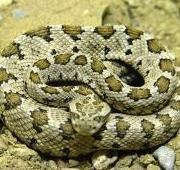 Rattlesnake are poisonous snakes that belong to the pit viper group and are recognized by the distinctive rattle on the end of their tail. Most species of rattlers have hemotoxic venom that attacks tissues and destroys them. The Mojave rattlesnake also has a neurotoxin in its venom making it the most dangerous of all the species of rattlesnakes.
Rattlesnakes vary considerably in color depending on their habitat. In the western states the author has observed pinks, greens, rust colors, and almost black. They tend to blend well with their background. Some species are more reactive to threats than others, but most would rather run away than have an encounter with a human. They use their heat sensing pits on their faces to "see" heat images. They track wounded prey by following its heat signature.
They use their poison to subdue their prey, small mammals like rabbits and mice. The venom starts digesting the prey from the inside before the snake even swallows it. Venom is also used defensively when the snake feels threatened. They are able to use as much or as little venom as they wish. Up to 1/3 of bites to humans are dry bites with no venom injected. Treatment involves putting a constriction band around the limb above the bite and getting quickly to a hospital for antivenom treatment.
They are prey themselves to kingsnakes, roadrunners, pigs, eagles and hawks.
Rattlesnake are poisonous snakes that belong to the pit viper group and are recognized by the distinctive rattle on the end of their tail. Most species of rattlers have hemotoxic venom that attacks tissues and destroys them. The Mojave rattlesnake also has a neurotoxin in its venom making it the most dangerous of all the species of rattlesnakes.
Rattlesnakes vary considerably in color depending on their habitat. In the western states the author has observed pinks, greens, rust colors, and almost black. They tend to blend well with their background. Some species are more reactive to threats than others, but most would rather run away than have an encounter with a human. They use their heat sensing pits on their faces to "see" heat images. They track wounded prey by following its heat signature.
They use their poison to subdue their prey, small mammals like rabbits and mice. The venom starts digesting the prey from the inside before the snake even swallows it. Venom is also used defensively when the snake feels threatened. They are able to use as much or as little venom as they wish. Up to 1/3 of bites to humans are dry bites with no venom injected. Treatment involves putting a constriction band around the limb above the bite and getting quickly to a hospital for antivenom treatment.
They are prey themselves to kingsnakes, roadrunners, pigs, eagles and hawks.



